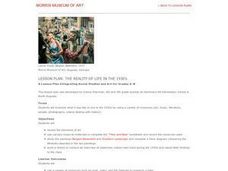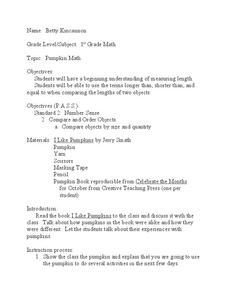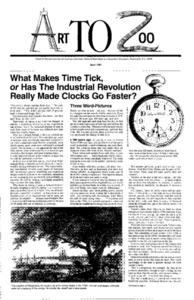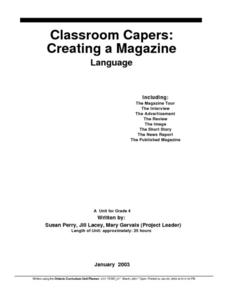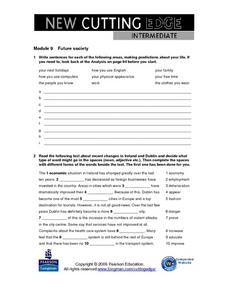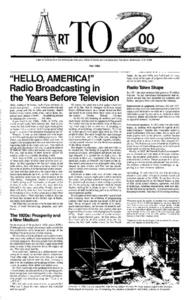Curated OER
The Reality of Life in the 1930s
Students examine the life style of the 1930's using art, music, the Internet and interviews as resources. They complete worksheets including a Venn diagram comparing two pieces of artwork. They determine what life during the Great...
Curated OER
Pumpkin Math
Students discover how to measure the circumference of objects. In this measurement lesson, students use a pumpkin and a tape measure to estimate and find the circumference of the pumpkin.
Brain Parade
See.Touch.Learn.
Here is a great app that has tons of potential in helping your child or student with severe to moderate autism, or other intellectual disability, learn words and concepts using research-based methods. Children with autism or PDD NOS have...
Curated OER
Gravity (Newton's Laws of Motion): A Weighty Subject
Students identify Newton's Laws of Motion. They students explore Newton's Laws of Motion and apply the second law with a classroom activity. The videos will provide visual examples of the effects of gravity while riding on a roller coaster.
Curated OER
The Science Behind Tsunamis
Natural disasters can be teachable moments that create more scientifically literate citizens.
Curated OER
The Constitution Lives! How it Protects Your Rights Today
Students brainstorm their rights as Americans. In this The Constitution Lives! instructional activity, students discern the difference between rights and rules by completing a worksheet. Students consider the differences between types of...
Curated OER
What Makes Time Tick, or Has the Industrial Revolution Really Made Clocks Go Faster?
Students explore the concept of time both historically and in their own lives. Students count the number of times they refer to a clock and the number of scheduled and unscheduled activities in their lives. Students discuss how the...
Curated OER
Newspaper Layout
In this newspaper worksheet, students follow the directions of this newspaper layout in order to create a newspaper. Students follow 5 sets of directions.
Curated OER
School, Unplugged
What would school be like if you couldn't teach lessons that require technology? Would it benefit the class? Would it hold them back? Have your learners read this article and answer the basic reading comprehension questions. Then have...
Curated OER
Read All About it
Learners create and publish a newspaper that reflects and explains pioneer and medieval societies. They become newspaper writers for a specific time period. They adopt a holistic approach to exploring community life in medieval and...
Curated OER
Classroom Capers: Creating a Magazine
Fourth graders build language skills in the context of creating a classroom magzine. They participate in activities which help students communitcate ideas and information for a variety of purposes and for specific audiences using the...
PACER Center
The Peer Advocacy Guide
Teasing, mocking, and disrespect can be the hallmarks in the life of those with disabilities. Disrupt the cycle of abuse with a toolkit designed to turn peers into advocates for all those who are bullied. Everything needed to create a...
Curated OER
Comparing Deciduous and Evergreen Trees
Students investigate nature by identifying different plants and trees. In this environmental field trip, students participate in a British Columbia expedition in which they identify cedar, pine, hemlock and Douglas fir trees. Students...
Curated OER
In Touch with Apples
Students read "How To Make an Apple Pie and See the World", the story of a girl who traveled the world to find the ingredients to make her apple pie. They conduct a series of interdisciplinary activities including testing their senses,...
Curated OER
Module 9--Future Society
In this making predictions worksheet, students write nine sentences about various areas making predictions about their lives. Students read a text about recent changes in Ireland and Dublin and decide what type of word might fit...
Curated OER
Four Corners Debate
Should the student population wear uniforms to school? Pupils express whether they strongly agree, agree, disagree, or strongly disagree with a controversial statement, moving to a designated corner of the room to indicate their stance....
Curated OER
Transportation Fuels: Biodiesel
Students examine biodiesel as a fuel for transportation. For this biodiesel lesson students complete activities using their critical thinking.
Curated OER
Read All About It! Events and People of the 1930s and 1940s That Shaped California and the Nation.
Learners look carefully at four photographs by Dorothea Lange and discuss them in terms of what is depicted and what she may have wanted to communicate. They review what they learned about the Dust Bowl, the Depression, the war era, and...
Curated OER
Radio Broadcasting Before Television
Students compare the radio to other forms of mass communication. In this Radio Broadcasting Before Television lesson, students learn the different types of radio shows in the 1920s and 30s. Students write and perform radio scripts...
Curated OER
House Keys: The Architectural Features of Victorian Homes and Buildings
Learners analyze Victorian architectural patterns wit regard to materials, doorways, windows, towers, bays, roofs, and decoration. Students discern varying architectural traits by studying Victorian era pictures and drawings and using a...
Curated OER
Alaskan Eskimo Collection
Students analyze mystery photographs to determine key characteristics about the Alaskan environment and Eskimo culture. In this Eskimo lesson, students read an Eskimo folktale and write their own in response. Lastly students complete a...
Curated OER
Why Do We Have Night?
Learners engage in a fun, creative way to discover how the Earth moves. This lesson helps students explain why there is day and night. It can also create curiosity to further study the solar system and eclipses!
Curated OER
Natural Features of Our Community
Second graders read about and discuss natural features of communities. They listen to a guest speaker, such as a park ranger to expand their knowledge of natural features. They go on a field trip, if possible, to a local zoo or...
Curated OER
Air Is All Around Us!
Students design an instrument to show that air is all around. In this air lesson plan, students research, construct, and present a design that proves that air is all around, even though they can't see it or touch it. A teacher and self...


